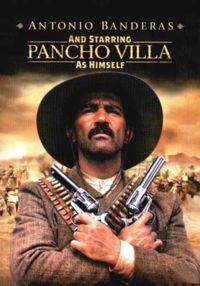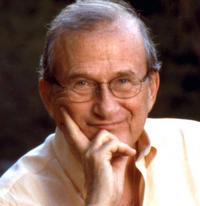
Larry Simon Gelbart was an American television writer, playwright, screenwriter, director and author, most famous as a creator and producer of the television series M*A*S*H, and as co-writer of the Broadway musicals A Funny Thing Happened on the Way to the Forum and City of Angels.

José Antonio Domínguez Bandera, known professionally as Antonio Banderas, is a Spanish actor and filmmaker. Known for his work in films of several genres, he has received various accolades, including a Cannes Film Festival Award and a European Film Award, in addition to nominations for an Academy Award, a Tony Award, two Primetime Emmy Awards, and five Golden Globe Awards.

Viva Villa! is a 1934 American pre-Code film directed by Jack Conway and starring Wallace Beery as Mexican revolutionary Pancho Villa. The screenplay was written by Ben Hecht, adapted from the 1933 book Viva Villa! by Edgecumb Pinchon and O. B. Stade. The film was shot on location in Mexico and produced by David O. Selznick. There was uncredited assistance with the script by Howard Hawks, James Kevin McGuinness, and Howard Emmett Rogers. Hawks and William A. Wellman were also uncredited directors on the film.

Francisco "Pancho" Villa was a Mexican revolutionary and general in the Mexican Revolution. He was a key figure in the revolutionary movement that forced out President Porfirio Díaz and brought Francisco I. Madero to power in 1911. When Madero was ousted by a coup led by General Victoriano Huerta in February 1913, Villa joined the anti-Huerta forces in the Constitutionalist Army led by Venustiano Carranza. After the defeat and exile of Huerta in July 1914, Villa broke with Carranza. Villa dominated the meeting of revolutionary generals that excluded Carranza and helped create a coalition government. Emiliano Zapata and Villa became formal allies in this period. Like Zapata, Villa was strongly in favor of land reform, but did not implement it when he had power. At the height of his power and popularity in late 1914 and early 1915, the U.S. considered recognizing Villa as Mexico's legitimate authority.

Viva Zapata! is a 1952 American Western film directed by Elia Kazan and starring Marlon Brando. The screenplay was written by John Steinbeck, using Edgcomb Pinchon's 1941 book Zapata the Unconquerable as a guide. The cast includes Jean Peters, and in an Academy Award-winning performance, Anthony Quinn.

Alan Wolf Arkin was an American actor and filmmaker. In a career spanning seven decades, he received numerous accolades, including an Academy Award, a BAFTA Award, a Golden Globe Award, and a Tony Award as well as nominations for six Emmy Awards.

Raoul Walsh was an American film director, actor, founding member of the Academy of Motion Picture Arts and Sciences (AMPAS), and the brother of silent screen actor George Walsh. He was known for portraying John Wilkes Booth in the silent film The Birth of a Nation (1915) and for directing such films as the widescreen epic The Big Trail (1930) starring John Wayne in his first leading role, The Roaring Twenties starring James Cagney and Humphrey Bogart, High Sierra (1941) starring Ida Lupino and Humphrey Bogart, and White Heat (1949) starring James Cagney and Edmond O'Brien. He directed his last film in 1964. His work has been noted as influences on directors such as Rainer Werner Fassbinder, Jack Hill, and Martin Scorsese.
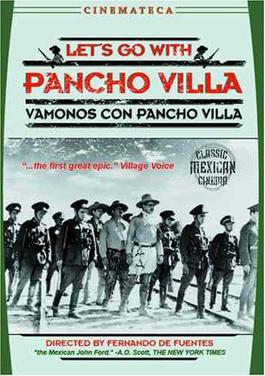
Let's Go with Pancho Villa is a Mexican motion picture directed by Fernando de Fuentes in 1936, the last of the director's Revolution Trilogy, besides El prisionero trece and El compadre Mendoza.

Eion Francis Hamilton Bailey is an American actor.

Michael Engler is an American theater director, and a Directors Guild of America and Emmy nominated television director and producer.
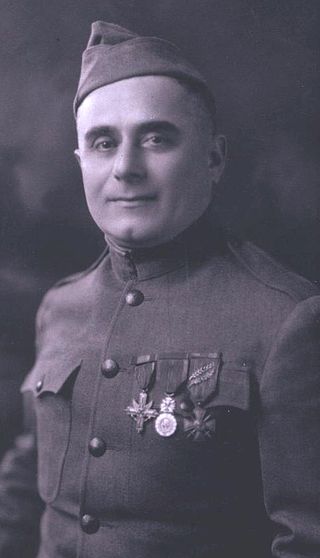
Samuel Dreben, sometimes misspelled "Drebben" or "Drebin", and known as "The Fighting Jew", was a highly decorated soldier in the US Army and a mercenary who fought in a variety of wars and revolutions.

The First Battle of Rellano was an engagement on 24 March 1912 during the Mexican Revolution at the Rellano railroad station, in the state of Chihuahua. It was fought between government troops loyal to Francisco I. Madero, led by General José González Salas, and rebel troops under Pascual Orozco. The battle was a victory for Orozco.
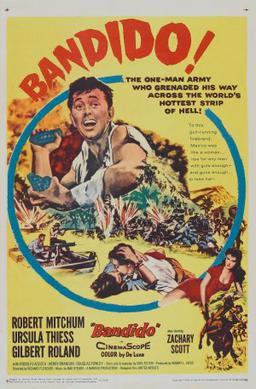
Bandido is a 1956 American western film directed by Richard Fleischer and starring Robert Mitchum, Ursula Thiess, Gilbert Roland, and Zachary Scott. The film, set in the Mexican Revolution and filmed on location around Acapulco, was written by Earl Felton. Robert Mitchum also co-produced the film through his DRM Productions company.
The Life of General Villa (1914) is a silent biographical action–drama film starring Pancho Villa as himself, shot on location during a civil war. The film incorporated both staged scenes and authentic live footage from real battles during the Mexican Revolution, around which the plot of the film revolves. The film was produced by D. W. Griffith and featured future director Raoul Walsh as the younger version of Villa.
Tony Mark is an American film producer, director and screenwriter. He has worked with Kathryn Bigelow and Robert Rodriguez.
Pancho Villa was famous during the Mexican Revolution and has remained so, holding a fairly mythical reputation in Mexican consciousness, but not officially recognized in Mexico until long after his death. As the "Centaur from the North" he was considered a threat to property and order on both sides of the border, feared, and revered, as a modern Robin Hood.

The First Battle of Torreon, also known as the Capture of Torreon, which lasted from September 27 to October 1, 1913, was one of the battles of the Mexican Revolution, where revolutionaries led by Pancho Villa occupied a city protected by Huertist federal forces. The victory in his first large battle of the Mexican Revolution brought Villa not only a huge increase in prestige, but also considerable spoils of war in the form of urgently needed military equipment of all kinds.
The Third Battle of Torreón from December 21 to 23, 1916, was one of the battles of the Mexican Revolution, where troops led by Pancho Villa occupied the city, protected by Carrancist forces.
In the history of Mexico, the Pact of Torreón was a plan drawn up during the Mexican Revolution in early July 1914 by generals of the Constitutionalist Army in the important northern city of Torreón, Coahuila. The pact was framed as a modification of Venustiano Carranza’s 1913 Plan of Guadalupe, which was a narrow political plan. The pact called for a constitutional convention to revise the 1857 Mexican Constitution. It excluded commanders in the Constitutionalist Army from running for the presidency of the republic in the future. It called for the end of the Federal Army, at the time commanded by former general, now president of Mexico, Victoriano Huerta. The Pact of Torreón added to Plan of Guadalupe language that was more radical than Carranza’s, prompting Carranza to issue "Additions to the Plan of Guadalupe".
